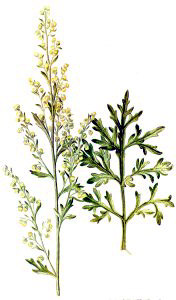La Fee Verte
If memory serves me correct, absinthe was one of the most popular urban (intoxication) legends of my college career. However, long after the tales of highs from banana skins and morning glory seeds (don't pretend that you don't understand the reference) dissipated, the wonders of wormwood have maintained their allure with age. Recently, I have been fortunate to sample several varieties, and receive a small education on the topic.
Aside from the alleged hallucinogenic effects, absinthe rose to fame in turn of the century France where it was featured in so many of those belle epoque posters that foreshadowed the rise of Absolut ads. Absinthe is an extremely alcoholic liquor that is light green in color (think neon patina), and features an overwhelming anise flavor.
Of course, there is a reason that, say, zambuca does not hold the cache of absinthe. That reason is Artemisia Absinthium or wormwood. The flowers and leaves of this plant are the most famed portion of a mix of florals in the recipe. Wormwood is rumored to cause mild hallucinations known as absinthinium, hence the popularity amongst the college crew.
 A second source of attraction is the thrill of the forbidden. By the start of the First World ar, absinthe was illegal in virtually every nation. (Switzerland amended their constitution to include the ban.) Fortunately, by the early nineties, the totalitarian teams of teetollers had been repulsed and Europe began to legalize the product once more.
A second source of attraction is the thrill of the forbidden. By the start of the First World ar, absinthe was illegal in virtually every nation. (Switzerland amended their constitution to include the ban.) Fortunately, by the early nineties, the totalitarian teams of teetollers had been repulsed and Europe began to legalize the product once more.
Where It Gets Confusing...
Okay. So maybe you have a friend who bought the juice back from Prague? Presumably, you then put the sugar on the spoon, used the capillary effect to absorb some water, then caramellized the whole batch in a stunning pyrotechnic display?
That is quite a bit of fun, but really neither absinthe nor the absinthe experience!
Czech absinthe is made from an entirely different process; in fact, it is not even distilled, more flavored or infused.
Actual absinthe is marked by the highly oily content. These oils and aromas are released through louching, or that business with the spoon. Specifically, the absinthe is iced down, and then cold water is poured over sugar on a spoon. Consequently, the saturation point is broken and the oils are released causing a cloudiness in the cup.
Tasting...
However, as I write, it becomes apparent that the best way to understand the liquor is to experience it! Absinthe is actually quite common; many upper end restaurants stock the drink at their bars, and all one must do is ask. Less scrupulous characters than myself have also been known to order bottles online. Either way, like any spirit, there are degrees of quality. My personal favorite is Jade, a company that purchased all of the Pernod equipment, and produces the libation in exact accordance with the original recipes.
Aside from the alleged hallucinogenic effects, absinthe rose to fame in turn of the century France where it was featured in so many of those belle epoque posters that foreshadowed the rise of Absolut ads. Absinthe is an extremely alcoholic liquor that is light green in color (think neon patina), and features an overwhelming anise flavor.
Of course, there is a reason that, say, zambuca does not hold the cache of absinthe. That reason is Artemisia Absinthium or wormwood. The flowers and leaves of this plant are the most famed portion of a mix of florals in the recipe. Wormwood is rumored to cause mild hallucinations known as absinthinium, hence the popularity amongst the college crew.
 A second source of attraction is the thrill of the forbidden. By the start of the First World ar, absinthe was illegal in virtually every nation. (Switzerland amended their constitution to include the ban.) Fortunately, by the early nineties, the totalitarian teams of teetollers had been repulsed and Europe began to legalize the product once more.
A second source of attraction is the thrill of the forbidden. By the start of the First World ar, absinthe was illegal in virtually every nation. (Switzerland amended their constitution to include the ban.) Fortunately, by the early nineties, the totalitarian teams of teetollers had been repulsed and Europe began to legalize the product once more.Where It Gets Confusing...
Okay. So maybe you have a friend who bought the juice back from Prague? Presumably, you then put the sugar on the spoon, used the capillary effect to absorb some water, then caramellized the whole batch in a stunning pyrotechnic display?
That is quite a bit of fun, but really neither absinthe nor the absinthe experience!
Czech absinthe is made from an entirely different process; in fact, it is not even distilled, more flavored or infused.
Actual absinthe is marked by the highly oily content. These oils and aromas are released through louching, or that business with the spoon. Specifically, the absinthe is iced down, and then cold water is poured over sugar on a spoon. Consequently, the saturation point is broken and the oils are released causing a cloudiness in the cup.
Tasting...
However, as I write, it becomes apparent that the best way to understand the liquor is to experience it! Absinthe is actually quite common; many upper end restaurants stock the drink at their bars, and all one must do is ask. Less scrupulous characters than myself have also been known to order bottles online. Either way, like any spirit, there are degrees of quality. My personal favorite is Jade, a company that purchased all of the Pernod equipment, and produces the libation in exact accordance with the original recipes.

0 Comments:
Post a Comment
<< Home